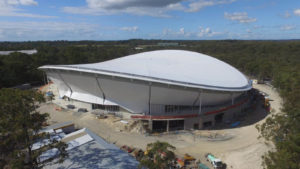
The Queensland State Velodrome is a new indoor track facility in Queensland, Australia. This facility will play a major role in the staging of the Gold Coast Commonwealth Games™ in 2018, hosting the track cycling competition. The velodrome, located alongside the Brisbane Super X BMX Track at the Sleeman Sports Complex, is slated to provide a range of sport and recreation facilities in addition to competitive cycling events. German company Sportbau Schurmann GBH designed and built the velodrome track to Union Cycliste Internationale (UCI) standards, featuring a wide track for team pursuit cycling. The $59 million velodrome is located in the southeast Brisbane suburb of Chandler.
The project is notable for its large saddle-form roof of more than 10,000 square meters. The stadium is custom designed for natural ventilation and lighting. To achieve those goals, elements of the walls and roof of the velodrome were designed and constructed with architectural fabric. The large steel superstructure is clad on the walls and roof with a combination of block out and translucent fabric.
The Fabric
The roof span of the stadium stretches 120 meters from north to south and 110 meters from east to west. Block out fabric was required for the walls and a portion of the roof, but fabric above the track area needed to be an 8 percent translucency to enable natural lighting for cyclists. MakMax Australia of Queensland worked with fabric manufacturer Chukoh Chemical Industries Ltd., Tokyo, Japan, to create the PTFR fabric with custom translucency. In total, the installation required 23 roof panels and 20 wall panels.
“Fabric was the most cost effective solution for both roof and walls,” says MakMax managing director Michael Lester. “This was driven by the 3D shape of both, which would have been difficult to achieve in other typical building materials. The translucency of fabric also offered natural lighting of the interior space, further adding lifetime cost benefits.”
Natural lighting of the track was an important goal to accommodate cyclists and other events. “In partnership with the fabric manufacturer,” Lester says, “we developed a custom block out PTFE fabric and an 8 percent translucency fabric (compared to the standard 12 percent). Chukoh Chemical Industries was proactive in developing [both] fabrics and both fabrics were developed specifically for this project.”
The fabric design solution for the velodrome was favored by the project’s architect. Lester explains, “The fabric design was driven by the shape of the track, the best spectator viewing lines to the action on the track and the need to break up the expanse of the façade with tessellations.” The white color was chosen for its solar heat gain advantages and transmittance of daylight.
The Installation
The fabric panels were attached to support structures using aluminum keder track extrusions. “For the roof, a special low profile extrusion was used to minimize interference with the roof water flow lines on the relatively flat roof,” Lester says. “A tie down tee keder was used on both walls and roof where intra-panel tie down was required.”
The support structure was designed by Arup and Tensys Structures, Victoria, Australia, in consultation with MakMax. “Fabrication of the membranes was shared between Brisbane and our Mizuho factory,” says Lester. “The fabrics where installed by Sydrig.” He explains that a team of 15 riggers was used to install the paneling. The crew gained access to the connecting points by elevated work platforms and scaffolding. The membranes were tensioned manually on threaded rods. The 18-month project was finished on schedule with minor challenges. “The wedge-shaped panels were difficult to tension into the wedge,” Lester says, but in the end, the installation was a total success.
As Queensland’s first indoor velodrome, officials hope this new facility will attract elite training squads and competition events to further develop cycling in Queensland. The new velodrome will be more than just a track cycling facility—the infield area will have the capacity to provide for a range of additional sports and recreational uses.
The project won an Award of Excellence in IFAI’s 2016 International Achievement Awards program.
Jake Kulju, a frequent contributor of IFAI publications, is a freelance writer from Shafer, Minn.
 TEXTILES.ORG
TEXTILES.ORG


